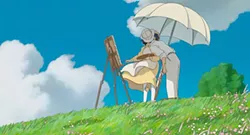The Wind Rises | B
Hayao Miyazaki owes us nothing. At 73, the undisputed maestro of anime, and one of the world’s greatest cinematic artists, has announced that he’s done making pictures, and that this weirdly ethereal and oddly moving, fictional biographic tribute to the creator of the infamous Mitsubishi A6M “Zero” fighter planes, will be his last film. Fans, of which Miyazaki has legions, have loudly bemoaned his retirement threat, and have to a large degree been baffled by the master’s dubious choice of subject matter for his swan song. The hand wringing may be a bit excessive. The Wind Rises, in its own mysterious, inimitable ways, is a fitting farewell for a director committed to the power of creativity — one who knows that once released upon the world, their creations are no longer strictly their own.
Young Jiro Horikoshi (Joseph Gordon-Levitt) is a spindly, bright young dreamer, who figuratively lives with his head in the clouds; forever dreaming and thinking about flight and the construction of better and faster flying machines. He is sometimes aided in his cloud buzzing daydreams by the spirit of Italian aeronautical visionary Gianni Caproni (Stanley Tucci), though in a typically sly Miyazaki touch, the sage insists that Jiro is in fact a visitor in the older man’s dreams.
While Jiro keeps looking skyward, the world beneath his feet keeps spinning through natural disasters, economic ruin, and through the increasing drum beats of war. In college, the achingly shy and gentlemanly Jiro begins a long, slow smoldering romance with a frail, tubercular and decidedly earthbound beauty Nahoko (Emily Blunt). Every time she coughs we are reminded that their love is as doomed as the paranoid Empire that funds Jiro’s work, but the science-minded, perpetually distracted hero refuses to see what sadness lies ahead of him.
Aside from a few haunting fantasy sequences, we never see the death and destruction that Jiro’s inspiration causes, and while he’s more interested in progress than war, his only real protest to the weaponizing of his work is a joke that the plane would be lighter without the guns. Miyazaki is never assertive about the politics, instead striking a reflexive, thoughtful tone. There is a lingering sense of nostalgia, that Japanese people of a certain age look on the war years as a time of purpose and honor, but also hints of deep regret and shame, not just for the carnage, but for the Nation’s failure. The gentleness and sentimentalism here might seem ill suited to the heavy subject, but it is in keeping with the director’s famous style. Despite the dream moments, The Wind Rises is grounded in reality, mostly lacking the enchanted beasts and playful deities that grace the filmmaker’s earlier masterpieces like Spirited Away and My Neighbor Tototro, but there is a sense of wonder. From the rivets in the wings to strands of hair, to puffs of chimney smoke, every beautifully hand drawn animated thing here is alive, carried aloft by fate and, yes, by magic in the air. —Corey Hall
The Wind Rises | B-
There is a point in Hayao Miyazaki's lusciously animated biopic where a character tells Jiro Horikoshi, the film's protagonist, that all things being equal, he prefers "a world with pyramids." The implication is, of course, that even though the Pyramids were built upon the blood and backs of slaves, our world is better for having them.
It is an argument Louis C.K. brilliantly deconstructs in his “But maybe...” comedy routine: That the human race can accomplish amazing things when it doesn't give a shit about the pain, death and suffering that others will endure.
Though I am hardly on the side of the Pyramids, I certainly understand the value of the point being made. But as an excuse for producing a nonjudgmental film about the aeronautical engineer who happily designed fighter planes for the megalomaniacal Japanese military of WWII, it seems an ill-fit for a filmmaker whose work has often criticized the belligerent impulses that foment war. It's like celebrating the career of J. Robert Oppenheimer without ever acknowledging the devastation visited upon Hiroshima or Nagasaki.
We first meet Jiro (Joseph Gordon Levitt) before he dreams of Zeros. Instead he visits his favorite airplane designer Giovanni Caproni (voiced by Stanley Tucci). “Airplanes are beautiful dreams,” his ghostly mentor tells him. But soon nightmares take over, as strange war-like demons attack. It is the only time Jiro wrestles with the implications of his chosen field.
Because of poor eyesight, Horikoshi takes up engineering instead of flight. Miyazaki follows him through the great Kanto Earthquake of 1923, to his early years designing aircraft for Mitsubishi, to his courtship of tubercular Nahoko (Emily Blunt), to his fateful visit to Germany where he learns how the Junkers build their warplanes (nary a swastika or Iron Cross is to be seen). Along the way it is clear that Miyizaki is trying to focus his story on the purity of creation Jiro seeks, not the impurity of of their use. Wielding his slide rule like a sword and consumed with a boundless love of aviation, he is presented as an artist of sorts – albeit, a polite and incurious nerd of an artist whose passion for planes is nearly matched by his passion for smoking.
But if Miyazaki is claiming that an artist cannot be held responsible for how his art is abused, his film makes a poor case of it. The fact that Jiro's beautifully designed machines will be used to massacre others is never once questioned. He isn't just incurious about this, he seems morally apathetic. In one scene, Jiro shows off his designs for a fast and graceful plane that, unfortunately, won't work with guns mounted on it. Laughing, he discards the plans for those that will accommodate bombs and machine-guns.
It could be argued that Miyazaki is subtly attempting to demonstrate how Japanese nationalism blinded Jiro to the implications of his designs, how governments corrupt the passions of the naive for their own militaristic purposes. But the message is hard to discern since his protagonist rarely encounters conflict and the film so assiduously holds the specifics of WWII at arm's length.
This detached view of Japan's behavior during the war is in sync with the country's official stance — often denying its darker history — but contrasts greatly with movies like Howl's Moving Castle, Princess Mononoke, and Nausicaä of the Valley of the Wind. In those films Miyazaki argued openly and passionately that harmony, compassion, and understanding were needed to achieve peace, and that war was poisonous to both the victims and the victors. The Wind Rises is neither persuasive as a plea for peace nor a criticism of war.
Nevertheless, it does feature Miyazaki's exquisitely wondrous animation. He has the unique ability to make his worlds feel vibrantly alive.The Wind Rises revels in the lush, green Japan of the past, unspoiled by urbanization. Though his frames are filled with every conceivable form of travel — steam trains, trolleys, dirigibles, airplanes, taxis and buses — each becomes a window onto which we view the gorgeous and wooded countryside that now seems but a dream of Japan. There is an intense nostalgia for simpler times that pervades Miyazaki's film, as oxen are shown to pull Jiro's prototype onto the airfield and paper airplanes instill wonder in the children who watch them ride the wind.
The film's numerous flying sequences are magnificently weightless, conveying why Jiro and his fellow designers are so enamored with the possibilities of flight. But the true show-stopper is the Kanto Earthquake sequence, where Jiro displays his sole instance of heroism. While rescuing Nahoko, the landscape heaves and lurches like a great monstrous beast, expelling great gouts of fire as it ravages villages in its wake. It's a glorious instance of animated cinema in an otherwise slow-moving drama.
As Miyazaki's supposedly last film (his declarations of retirement seem uncertain), there is an palpable sense of sadness and loss in The Wind Rises. You get the feeling that he is lamenting the loss of a simpler, more innocent world rather than insidious influences of war. Jiro's dying wife becomes sicker as his fighter plane designs get better and there is the echoing sentiment that no matter how pure his love, death and ruin are inevitable. But in the end, as Jiro walks through a dreamscape of broken planes beneath a sky filled with gleaming bombers, he mourns that his planes never came back, not the annihilation they delivered. It's curious that Miyazaki feels so much for a man who seemed to feel so little. —Jeff Meyers
The Wind Rises is rated PG-1,3 runs 126 minutes, and is in select theaters Friday the 28th.






